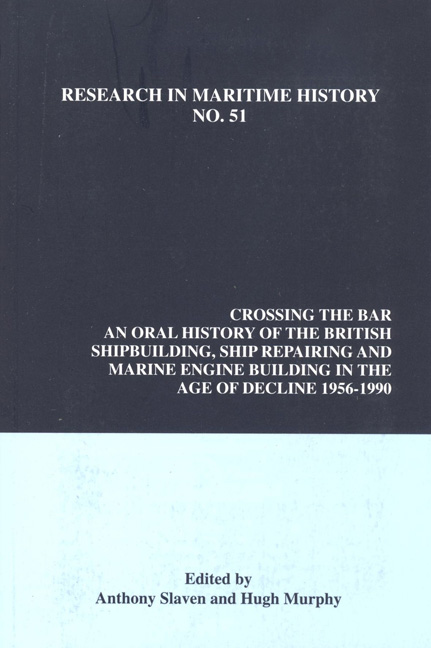 Crossing the Bar
Crossing the Bar Book contents
- Frontmatter
- Contents
- About the Authors
- Dedication
- Preface: A Shipbuilding Libretto
- Introduction
- Interviews
- Lower Clyde
- Upper Clyde
- The Tyne
- The Wear
- Barrow-in-Furness
- The South Coast
- The Humber
- Belfast
- British Shipbuilding Industry Officials
- The Trade Unions
- The Civil Servants, Board of Trade, Shipbuilding Enquiry Committee, Shipbuilding Industry Board, Ministry of Technology, Department of Trade and Industry, Department of Industry
- The Politicians
- Interviews British Shipbuilders Plc
- Conclusion
- Select Bibliography
Conclusion
- Frontmatter
- Contents
- About the Authors
- Dedication
- Preface: A Shipbuilding Libretto
- Introduction
- Interviews
- Lower Clyde
- Upper Clyde
- The Tyne
- The Wear
- Barrow-in-Furness
- The South Coast
- The Humber
- Belfast
- British Shipbuilding Industry Officials
- The Trade Unions
- The Civil Servants, Board of Trade, Shipbuilding Enquiry Committee, Shipbuilding Industry Board, Ministry of Technology, Department of Trade and Industry, Department of Industry
- The Politicians
- Interviews British Shipbuilders Plc
- Conclusion
- Select Bibliography
Summary
The rationale of this book has been to let the actors speak for themselves from a position of informed and measured opinion. From the contributions offered, the reader can readily discern patterns in the decline of the British shipbuilding industry and to a lesser extent that of marine engine-building and ship repair. In the conclusion we do not purport to analyze any contribution in detail except to give the reader some context into which to place the decline.
Prior to 1914, the British shipbuilding industry dominated world output, regularly accounting for around sixty percent of the world's ships. At the same time, the British mercantile marine was easily the world's largest trading fleet. The Royal Navy stood as the world's foremost navy, and Britain's combined naval and mercantile strength, inextricably linked to the Empire, made the nation the world's foremost maritime power.
The Great War and its aftermath radically altered Britain's position. Losses to U-boats, mines and other countermeasures were severe. After 1918, port congestion, the need to replace tonnage lost and a short-lived speculative boom that ended in 1920 when freight rates collapsed placed considerable strains on British shipbuilding, whose capacity had increased by forty percent during the war.
Interwar shipbuilding was characterized by excess capacity relative to demand. There were two real slumps in the early 1920s and early 1930s, a concomitant collapse in naval demand owing to international treaty limitations in place from 1921 to 1936, unemployment rates averaging thirty-two percent of the insured workforce during the 1920s and the rise of international competition fuelled by economic nationalism which led to uneconomic prices. British shipbuilding began its own rationalization scheme under National Shipbuilders Security Limited in 1930, and during the decade about one-third of the industry's capacity - first, entire shipyards, and then later, berths - was sterilized against any return to shipbuilding. Two great mixed naval and mercantile yards, Beardmore at Dalmuir on the Upper Clyde, Palmer's at Hebburn and Jarrow on the Tyne closed for good, with the latter leaving an unemployment rate of seventy percent in its wake. Profits were to a large extent restored, however, to the remaining mixed naval and mercantile firms - the largest ones in the industry - due to rearmament.
- Type
- Chapter
- Information
- Crossing the BarAn Oral History of the British Shipbuilding, Ship Repairing and Marine Engine-Building Industries in the Age of Decline, 1956-1990, pp. 229 - 236Publisher: Liverpool University PressPrint publication year: 2013


